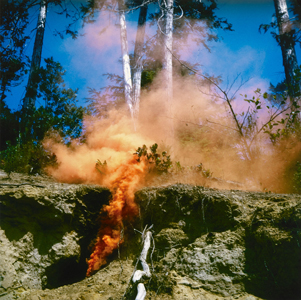
Born in 1939 in Chicago (US)

Year of Purchase: 2012
In October 1970, Judy Chicago put a personal ad in an issue of Artforum: an image showing her leaning on the ropes of a boxing ring, looking grim. She was wearing a sweatshirt with her name on it written in block letters. It was a powerful calling card for an emancipatory change of civil status: from then on, the artist would use the name of her native city rather than her father’s name (Cohen) or her husband’s (Gerowitz). The rehabilitation of the names of women engulfed by the patriarchal order would now become the goal of this activist who, in 1971, founded the first program of feminist art at Fresno State College in California.
The state of California, where she’d lived since 1959, had become a laboratory for new materials that went into experimentations with luminescence in the “Light and Space” movement and with the high-gloss art of the “Finish Fetish.” From airbrush painting to fiberglass and pyrotechnics, Chicago trained herself in supposedly masculine technologies, and, between 1969 and 1974, did a dozen outdoor performances which required specialized equipment such as flares, rockets, and fireworks. Immortalized in films and photographs, some of these performances were reprised in 2012 as part of the Getty Museum project, “Pacific Standard Time: Los Angeles Art, 1945–1980.” 1
If smoky environments were not entirely novel — Robert Morris, Sam Francis, and James Turrell had also experimented with them — those created by Judy Chicago seem particularly dramatic and baroque. Their vibrant colors prolong, by other means, the medium of painting that the artist had temporarily abandoned because her professors had rejected the exuberant palette of her “naïve proto-feminist imagery.” 2 For a time translated into multicolored minimalist sculpture, her pastel, slightly citrusy color palette soon achieved a gaseous form: infernal, pop purple smoke and gas blowing from the sea; an impressionist bouquet eclipsing the contours of a museum. Sometimes, these mild atmospheres become more menacing. Grey and black smokescreens enveloping a bridge in Fullerton, for example, are evocative of the toxic vapors used in Vietnam (Bridge Atmosphere at Noon # 3 , 1970).
Feminist with shaman tendencies, the series Women and Smoke (1971) staged nude women, their bodies entirely painted green, red, or purple, lighting and manipulating multicolored flares in the middle of the California desert. Priestesses of primitive societies, the women are the keepers of the source of fire, of energies, and power. Sitting cross-legged in the midst of red vapors, a green goddess repeats an ambivalent ritual reminiscent of the immolations of Vietnamese monks as well of the Indian practice of satī, which required that widows join their husbands’ remains in the funeral pyre (Immolation , 1970). Going beyond a simple perceptual experience, the artist’s smoke pieces reveal a transitional world, with no bearings or hierarchies. Marvelous mirages, they also partake of the incendiary and sulfurous potential of carnivals where shimmering masks temporarily invert the order of things.
Hélène Meisel
1 Public art and performance festival (January 19–29, 2012) organized as part of the program “Pacific Standard Time: Los Angeles Art, 1945–1980” (October 2011–March 2012, California).
2 “I started as a painter and moved into sculpture because my male teachers hated my ivory, turquoise and pink color sense. They also hated my kind of naive proto-feminist imagery” — Judy Chicago, interviewed by Glenn Phillips and Patrick Steffen, “Eleanor Antin and Judy Chicago. Proto-feminists at Work”, Flash Art, May–June 2012, p. 64.